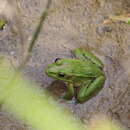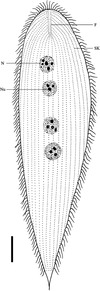Description
provided by AmphibiaWeb articles
Vomerine teeth present. Posterior part of the tongue free and forked. Toes webbed. Omosternum and sternum ossified. Pupil of the eye horizontal. When the shins are positioned perpendicularly to the body axis, the heels do not contact. Inner metatarsal tubercle high, compressed laterally. Dorsal coloration grey, greyish-olive, olive to green with large dark spots which are sometimes absent. So, two main coloration morphotypes may be distinguished: "green" and "grey". Numerous longitudinal wrinkles between the dorso-lateral folds. Light middorsal line and two lines on dorso-lateral folds usually present. No temporal spot. Belly white, sometimes with small amount of dark spots on throat. Males differ from females by having white vocal sacs behind the mouth angles and nuptial pads on the first finger.Few subspecies are recognized, but the structure of the species needs further study.
Nishioka, M., Sumida, M. and Ohtani, H. (1992). ''Differentiation of 70 populations in the Rana nigromaculata group by the method of electrophoretic analysis.'' Scientific Report of the Laboratory for Amphibian Biology Hiroshima University, 11(1), 1-70.
Distribution and Habitat
provided by AmphibiaWeb articles
The frog lives in Japan, Korea, China (Guangdong, Fujian, Hunan, Juangxi, Zhejiang, Jiangsu, Anhui, Hubei, Guizhou, Yunnan, Sichuan, Qinghai, Gansu, Shaanxi, Shanxi, Henan, Shandong, Hebei, Liaoning, Jilin, Heilongjiang provinces, as well as Ningxia-Hui and Inner Mongolia autonomous regions) and the former Soviet Union. In the latter area, the range is subdivided into two main parts: the Far East and Turkmenia. In the Far East, the frog is distributed in the valleys of the Amur and Ussuri Rivers and their tributaries. The westernmost Far Eastern known locality is Khinganskii Nature Reserve in the Amur Province (49º05'N,130º36'E). Tadpoles of the Dark-Spotted Frog were introduced in 1959 - 1961 with herbivorous fish fry from China (Hubei Province) into ponds of the Karamet-Niyaz Settlement, Kerki District, Turkmenia. Since the introduction, the species has successfully populated this locality. However, this population does not disperse along the Kara-Kum Channel over long distances. The Dark-Spotted Frog lives in meadows, different types of forests, bushlands and in desert (Turkmenia). Within these landscape types, it inhabits different types of water bodies, including river pools, channels, lakes, ponds, swamps, ditches and rice fields. In Turkmenia, the frog is strictly associated with riparian, overgrown parts of ponds, channels and irrigation ditches, whereas in the Far East it regularly occurs 2-15 m from water. In general, however, this frog displays a high site-fidelity. As a rule, it uses stagnant waters, rarely occurring in the shallows of rivers, covered with dense vegetation. It should be noted that in Turkmenia this species lives mainly separately from its relative, the autochthonous Marsh Frog (Rana ridibunda). Only in few ponds do these two species co-occur.
Life History, Abundance, Activity, and Special Behaviors
provided by AmphibiaWeb articles
Over a large part of the range, the Dark-Spotted frog is a common species, but the distribution in many areas is patchy, i.e. the frogs occur in dense groups. Hibernation occurs from late September - November to February - May in water, generally in large stagnant ponds and lakes, but sometimes in streams. Reproduction occurs soon after hibernation. Amplexus is pectoral (axillary). The clutch contains 600-5000 eggs. Metamorphosis occurs from May to August, depending on latitude and altitude. Sexual maturity is probably attained at an age of 2 years; maximum longevity is estimated to be 13 years. Tadpoles consume primarily plants (algae etc.). Adults primarily eat spiders, terrestrial insects and other invertebrates. Vertebrates (fish fry, amphibians etc.) are rarely eaten. Feeding does not cease during the breeding season.
Relation to Humans
provided by AmphibiaWeb articles
The species often occurs in anthropogenic landscapes, including towns and cities. There is a tendency towards dispersal of the species in the Far East.
Pelophylax nigromaculatus: Brief Summary
provided by wikipedia EN
Pelophylax nigromaculatus (formerly Rana nigromaculata), is a species of true frog found in East Asia, first described in 1861. This widespread and common frog has many common names, including dark-spotted frog, black-spotted pond frog, and black-spotted frog.
- license
- cc-by-sa-3.0
- copyright
- Wikipedia authors and editors


